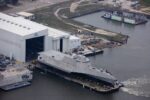China has delivered the NORINCO SR-5 multiple rocket launcher system (MLRS) to Mali—the first confirmed deployment of this modular artillery platform on the African continent. The transfer underscores Beijing’s growing strategic and defense footprint across Africa and reflects Mali’s pivot toward non-Western military suppliers amid ongoing regional instability.
SR-5 Delivery Marks Strategic Shift in Malian Defense Procurement
The delivery of the SR-5 system was confirmed by imagery released on social media and corroborated by open-source intelligence analysts. At least one launcher vehicle was observed being unloaded at Bamako-Sénou International Airport in early September 2025. This marks the first known export of the SR-5 to an African country.
Mali’s acquisition of the SR-5 follows a broader trend of diversification in its defense procurement strategy. Since 2021, Bamako has increasingly turned to Russia and China for arms supplies following deteriorating relations with France and the European Union. The arrival of Chinese artillery systems complements earlier deliveries of Russian armored vehicles and helicopters as part of a rearmament effort aimed at countering insurgent groups operating across central and northern Mali.
SR-5 Capabilities: A Modular Artillery System with Dual-Caliber Flexibility
The SR-5 is developed by China’s state-owned defense conglomerate NORINCO (China North Industries Corporation). It is a modular truck-mounted MLRS designed for rapid reconfiguration between different rocket calibers. The standard configuration allows for two interchangeable launch pods that can carry either:
- 20 x 122 mm rockets (based on Type 81/Type 90 lineage)
- 6 x 220 mm guided or unguided rockets
This flexibility enables commanders to tailor firepower for specific mission profiles—from saturation bombardment using unguided rockets to precision strikes using guided munitions like the BRE7 or Fire Dragon series. The system is mounted on a Wanshan WS2400 6×6 or similar chassis with high off-road mobility.
Key specifications include:
- Max range (122 mm): ~40 km
- Max range (220 mm guided): up to 70 km
- Reload time: ~10 minutes using resupply vehicle
- C4ISR integration via onboard FCS and digital fire control terminal
The SR-5 also supports integration with UAVs or forward observers for target acquisition—though it remains unclear whether Mali has acquired such complementary assets.
Mali’s Artillery Modernization Amid Counterinsurgency Campaigns
Mali’s armed forces have long suffered from logistical shortfalls and outdated equipment—particularly in artillery. Prior to recent procurements from Russia and China, Malian artillery relied heavily on Soviet-era D-30 howitzers and BM-21 Grad systems with limited C4ISR integration or mobility.
The introduction of a modern MLRS like the SR-5 provides several operational advantages:
- Enhanced standoff strike capability against insurgent camps or convoys
- Improved mobility over legacy towed systems
- Potential integration with ISR assets for dynamic targeting
This capability could prove decisive in operations against jihadist factions aligned with al-Qaeda or ISIS affiliates operating across Mopti, Gao, and Kidal regions—particularly if paired with improved intelligence collection platforms such as UAVs or SIGINT tools.
China’s Expanding Military Footprint Across Africa
The delivery aligns with China’s broader push into African security markets through arms sales, training programs, and base access agreements. According to SIPRI data (Stockholm International Peace Research Institute), China accounted for approximately 20% of African arms imports between 2018–2023—second only to Russia.
NORINCO systems have already been exported widely across Africa—including VT-series tanks (Nigeria), SH-series self-propelled howitzers (Sudan), Red Arrow ATGMs (Ethiopia), and Wing Loong UAVs (Egypt). The SR-series represents an effort by NORINCO to compete globally against U.S.-made HIMARS systems or Russian Tornado-G platforms by offering cost-effective modularity.
Mali’s procurement may also signal future interest from other Sahel states facing similar insurgency threats but constrained by Western export restrictions—such as Burkina Faso or Niger. China’s willingness to deliver complex weaponry without preconditions may accelerate this trend.
Operational Challenges Ahead for Malian Forces
Despite its advanced capabilities, integrating the SR-5 into Malian operational doctrine will pose challenges:
- Training: Effective use requires trained crews proficient in digital fire control systems—a capability gap likely addressed via Chinese advisors or contractors.
- Sustainment: Rocket resupply chains must be established; NORINCO typically supplies munitions alongside launchers under bundled contracts.
- C4ISR Integration: Without compatible ISR assets or command networks, full potential may not be realized.
If these hurdles are overcome—and if additional units are procured—the SR-5 could form the backbone of a new long-range strike capability within Mali’s Ground Forces Command structure.
Conclusion: A Symbolic Step Toward Strategic Realignment?
The delivery of China’s SR-5 MLRS marks more than just an artillery upgrade—it reflects a broader strategic realignment underway in West Africa. As traditional Western partnerships erode amid political instability and coups d’état across the Sahel region, countries like Mali are increasingly turning eastward for security assistance.
This shift carries implications not only for regional balance-of-power dynamics but also for future interoperability challenges should multilateral operations resume under UN or AU mandates. Whether this new capability translates into battlefield effectiveness remains contingent on training pipelines, sustainment logistics—and political will.









